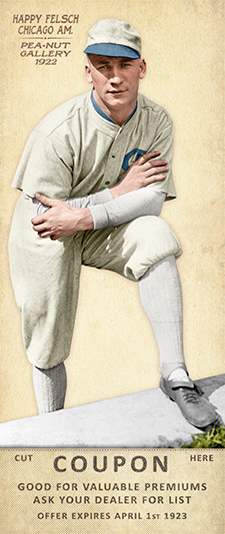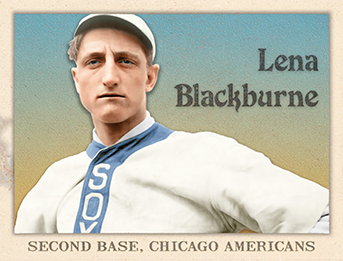- Series: 1919 Black Sox Scandal
- City: Chicago
- Team: White Sox
- League: American League
Charles Arnold Gandil (1888-1970) was described in the Chicago Tribune in March 1917 as “the ideal type of athlete – a fighter on the field, a player who never quits under the most discouraging circumstances and … is one of the most dangerous batters in the league when a hit means a ball game.” This tribute heralded Gandil’s return to his original club, Charles Comiskey’s White Sox. He didn’t set the world on fire in ’17 and ’18 but the club became a strong favorite to win it all in 1919. Rife with dissension directed at the miserly owner, by his own admission in a 1956 SI account, Gandil led a conspiracy to throw the Series. Everything came undone and by 1921 eight Sox players were banned for life. Gandil admitted to being the main instigator of the affair but insisted the actual Series losses were unintentional.
- Was a stand-out first-baseman for Clark Griffith’s Senators
- Lifetime BA of .277

- Series: 1919 Black Sox Scandal
- City: Chicago
- Team: White Sox
- League: American League
Oscar Emil Felsch (1891-1964) was a sunny-tempered soul, the epitome of the hail-fellow-well-met. Born into the German community of Milwaukee, Felsch excelled at baseball and went on to become the star center fielder for the Chicago White Sox for six seasons spanning the most tumultuous era in franchise and baseball history. Charles Comiskey brought Hap to the Windy City in 1915 as part of one of the most successful rebuilding efforts in the game’s history. Felsch joined future Hall of Famer Eddie Collins and the incomparable “Shoeless” Joe Jackson, forming a club that would become a dominant force in the American League through the WWI years. Indeed, he forged the kind of career that Jim Nitz of SABR states might have been remembered “as one of the best all-around center fielders in baseball history.” He led his hard-hitting team in home runs and slugging, he was a league-leader in both offensive and defensive stats. And everybody loved Hap.
Years after the sordid story of the Black Sox had waned, Felsch, amiable as ever, was virtually the sole source for writer Eliot Asinof’s Eight Men Out. Hap was as humble as he was forthright in recounting his role in the scandal that shook baseball and ushered in the Judge Landis autocracy that forever changed the structure of the game. “I shoulda knew better,” moaned the aged and infirm former slugger. Earlier he had testified to foreknowledge and acquiescence to the gamblers’ schemes, but always denied actively trying to lose a game, much less the Series.
Despite his reputation for a very sociable demeanor, Felsch suffered under the indignities inflicted by miserly Comiskey. Injuries, his brother’s war wounds, his father’s illness, all took a toll as well in 1919, as did the clubhouse friction between players riven by the war effort. Felsch, Jackson and others had taken defense-industry jobs in ‘18 while others had enlisted. Rivalries erupted and friendships were damaged. Into the tensions stepped unctuous underworld minions of east coast mobsters. The resulting scandal enmeshed Felsch and he never pretended innocence.
- After being ousted from organized ball by Landis, Felsch endured years of litigation mingled with varying efforts to play ball. Eventually he went north and enjoyed success in Canadian circuits while always maintaining the love and support of his hometown
- Series: 1919 Black Sox Scandal
- City: Chicago
- Team: White Sox
- League: American League
Edward Victor “Knuckles” Cicotte (1884-1969) won 208 games and a World Series with the White Sox in 1917. The Sporting News said in 1918 that “Perhaps no pitcher in the world has such a varied assortment of wares….” But it was Eddie’s first pitch of the 1919 Series that plunked Morrie Rath in the back and signaled the fix was in. No one was ever convicted of the infamous Black Sox scandal but Cicotte, with seven teammates, never played ML ball after his tearful confession following the ’20 season.
- Cicotte, Shoeless Joe, and other banned Sox players went on to barnstorm under false names
- His mastery of the knuckleball led to a transformation of his career. His control improved to the point of walking only 89 in 572 innings in 1918/19 combined.

- Series: Diamond Heads '15
- City: Chicago
- Team: White Sox
- League: American League
John Frank Fournier (1889-1973) has been ranked by Bill James as the 35th-best first baseman of all-time. Yet, his inability to play the position competently left the managers of his five major league teams in a constant quandary. He got his ranking at the plate, not afield. Always a good hitter, as his career progressed, Jack put up numbers with the best of the era. His career BA was .313 in 15 ML seasons and he really soared when the Cardinals dealt him to Zack Wheat's Brooklyn Robins. From 1923-26 Fournier averaged .337 and slugged 82 homers. His performance with the bat only improved as he aged. A recent ranking of hitters in their Age 34 to 36 seasons shows Fournier among twenty of the best ever. In fact, only he and Gavvy Cravath failed to make the Hall after achieving what he did in his mid-thirties. And he was no slouch in his twenties. Jack began his professional endeavors with Seattle in the Northwestern League in 1908. The teenager knocked around the west coast until the White Sox came calling in 1912. In two years he was hitting .300 and rarely dipped below that threshold thereafter. Had his glove been as magnetic as his body, Jack may have played even more—he led the league in being hit-by-pitch three times.
- Fournier may well have been the most mis-matched player of his day. The stratagems of the Dead Ball era dictated many bunts, a particular weakness for the sturdy fielder. And one is left to imagine the hits he'd have had with a livelier ball
- Jack almost quit the game rather than report to the Robins. He relented and went on to the best years of his career, despite leading the NL in errors his first season in Brooklyn

- Series: Diamond Heads '15
- City: Chicago
- Team: White Sox
- League: American League
Russell Aubrey Blackburne (1886-1968) was no great shakes as a player and had a sub-.500 career as a manager. Not many with a lifetime .214 average get mentioned at Cooperstown. But Lena had a bulldog spirit and a zeal to improve one key aspect of baseball: the sheen on the balls themselves. Until Blackburne’s “Rubbing Mud,” balls were doctored with tobacco juice, Shinola, and whatever the local swamps provided, all in an attempt to take some of the manufacturer’s shine off the spheres. Lena found a solution that still serves the game today. True to his discoverer’s spirit, he kept secret the source of the clay from which he made the rubbing compound. It was believed to be a spot on the Delaware River near his home. Blackburne had played for the White Sox, Reds, Braves, and Phillies before coaching and managing for the Sox, Browns and Athletics. He was enough of an AL-partisan to restrict use of his wonder-mud to the American League until the mid-1950s when the NL at last could partake.
- No other compound improved the grip on the ball without damage to the horsehide
- No one has gotten rich from the Mud. Team’s can get by with one 32-oz container per season at a cost of about $60. The current vendor of Blackburne’s concoction has to work full-time to support his family




